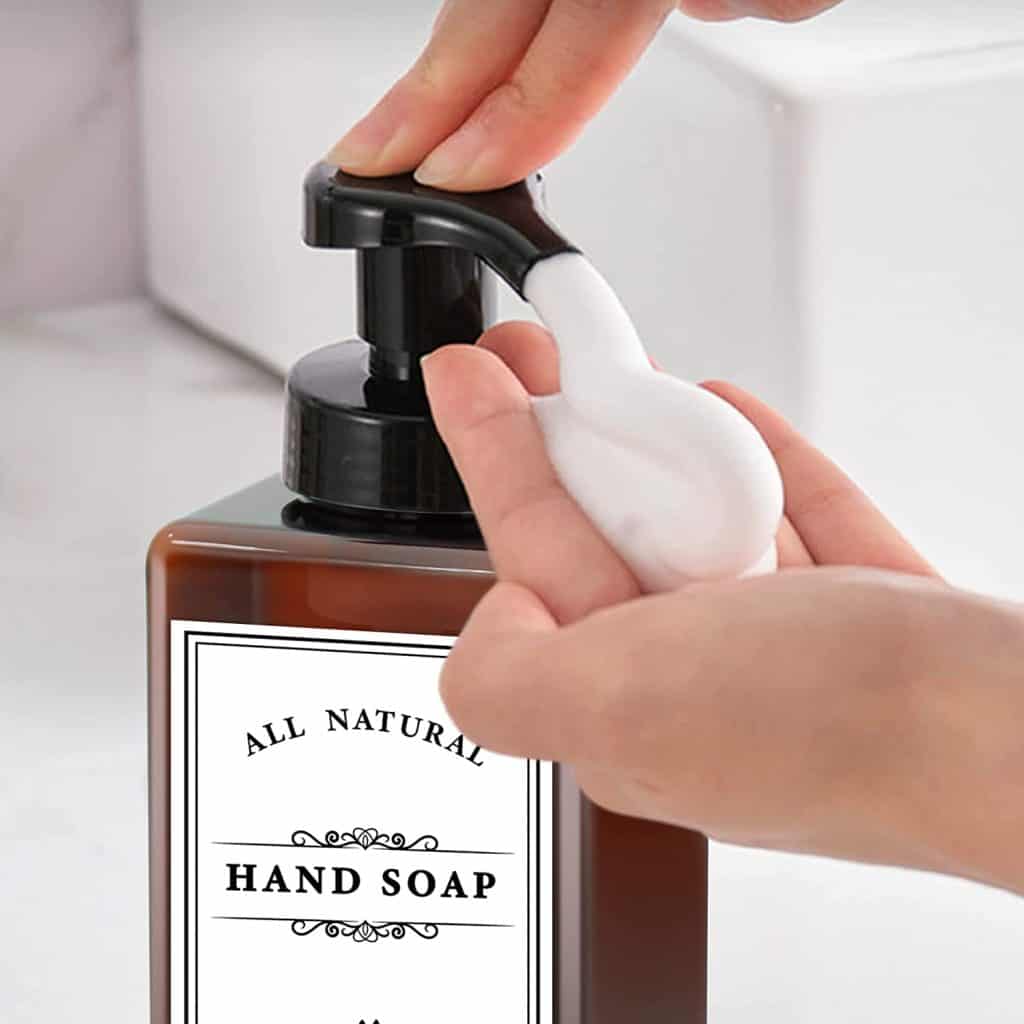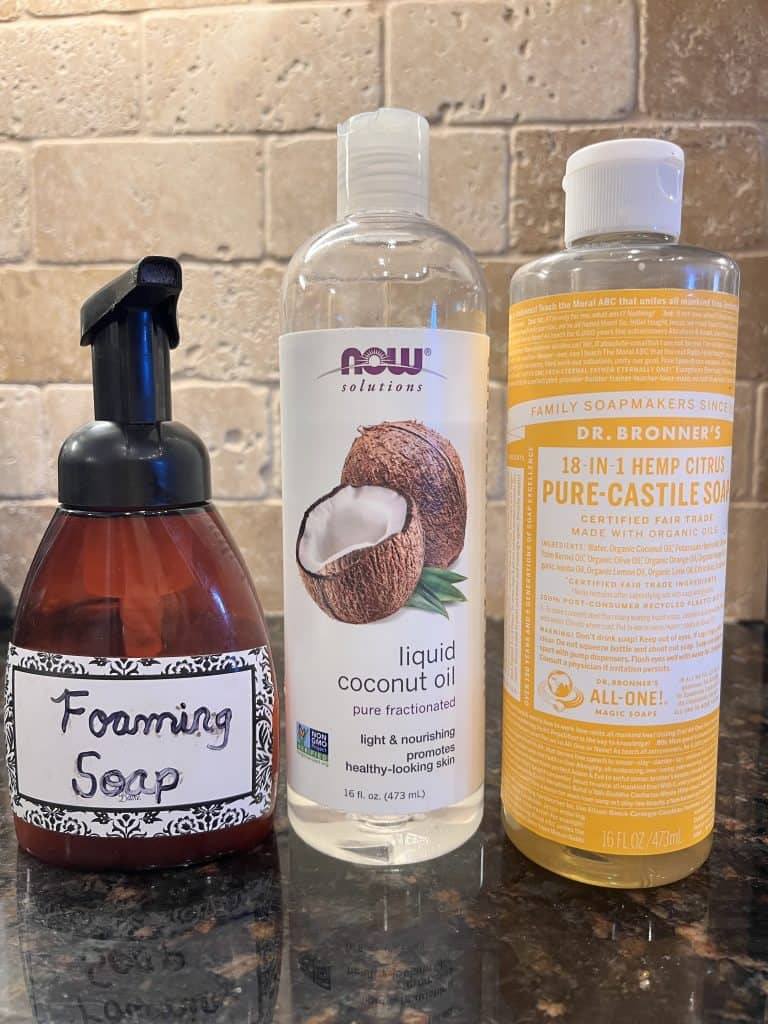
This site contains affiliate links to products. I may receive a commission for purchases made through these links at no extra cost to you.
Y’all, there is no such thing as a more simple DIY than homemade foaming hand soap. If you’re feeling lazy, it takes two ingredients. If you’re feeling fancy, it takes four. Either option takes about 30 seconds to make, and it’s so easy it can be a project to do with your kids!
Dangers of store-bought foaming soap
I, at one time, was a Bath and Body Works junky. Who can resist the wonderful scents, especially the seasonal ones?! This was the very last thing to go in our home after learning about dangerous chemicals we put on and around us. It wasn’t too hard to move away from the smelly lotions because I reasoned that was GOING ON my skin and STAYING ON my skin. Somehow soap didn’t seem as dangerous- I’m just lathering for a few seconds then washing it off afterall. (OK, I’ve always been a stickler to actually wash 20 seconds. I’ll never forget the “germs” my teachers put on our hands in nursing school and told us to go wash. Out came the UV light to show what a horrible job we actually all did! Gross! Twenty seconds of vigorous scrubbing it is, then!)
Excuse my trip down memory lane. Anyway, the store bought, strong smelling soaps stuck around awhile. In the last couple of years, as I’ve learned more, I’ve realized that short 20 seconds can actually be enough for things to absorb, not to mention all the chemicals you breathe in from all those scents!
You will need a PhD in chemistry in order to pronounce many of the ingredients on the ingredient list of any store-bought foaming soap! Methylchloroisothiazolinone anyone?
Ingredients to avoid
- Fragrance: This will also be listed as parfum. Doesn’t that sound all French and fabulous?! Sadly, it’s not as elegant as it sounds. The FDA has no requirements for every chemical in this concoction to be listed, so as to protect trade secrets. Under that one blanket word can hide dozens, if not HUNDREDS of toxic chemicals. Exposure to fragrances has been shown to negatively impact the central nervous system and can trigger allergies, migraines and asthma symptoms.
- Phthalates: (pronounced THAY-LATES) are one of the more sneaky ingredients. You can scour your ingredient lists all day long on chemical-laden products and never see this word. They are EVERYWHERE and detected in most of the US population. They are used in skin care products to lengthen the shelf life, but also to make fragrances last longer. Another reason to avoid fragrances. Phthalates have been linked to organ damage (specifically liver, lung and kidney), reproductive issues, and lowered IQ and ADHD in children.
- Sulfates: This is what gives a product lather. Sodium lauryl sulfate or sodium laureth sulfate are two examples you will see in products like soaps, body washes, and shampoo. They alter skin structure, allowing other chemicals to penetrate deep into the skin, increasing the amounts of other chemicals that reach the bloodstream. They can be a skin irritant, especially for those with sensitive skin.
- Antimicrobial agents: Thankfully, Triclosan was banned in 2016, but there is hardly ever a healthy replacement where big companies are concerned (think companies phasing out BPA only for us to find the newer replacements are even worse than the original!). The new antimicrobial being used in many hand soaps is Benzalkonium chloride. And, of course, there is a long list of issues with this chemical as well. News flash: we don’t need things to sanitize our hands when we are doing proper handwashing- hello 20 second rule! 🙂
Here is a more detailed list of chemicals to avoid and what products usually contain them:
https://lemongrassspa-cdn.azureedge.net/49002.pdf
Ingredients You Will Need for Making Foaming Hand Soap
If you’re new to making foaming soap, you’ll need some foaming soap dispensers. I wish these were around a couple years back when I bought mine- I love the pre-made labels! You can see I’m not some fancy script label writer on my picture below. Pre-made always looks good!
- Castile soap– I love Bronner’s because it’s known for its purity with no other ingredients added. Now, here is where I like to get lazy. 🙂 I mentioned the lazy way to make this homemade foaming hand soap was with two ingredients. Those would be water and Castile soap. The way requiring two more ingredients involves using essential oils. Those are lovely and you can truly create your own scent, but if you want a one-and-done, I love Bronner’s scented soaps! They are scented with essential oils and ready to go. My favorite is citrus but I also love peppermint around Christmas time. If you really want to cover your bases, they have a fabulous variety pack!
- Water
- Fractionated coconut oil (optional)
- Essential oils (of your choosing- optional)

Instructions for Making Homemade Foaming Hand Soap
Y’all, this is so simple it doesn’t even need to be put in bullet format! You just need to know your ratio. It’s one part Castile soap to 3 parts water. That’s it! So for one dispenser, you would need 1/4 cup Castile soap and 3/4 cup water. Place the water in the measuring cup first so you don’t have a sudsy mess! Then give a gentle stir. I find that I have to fill my dispensers around the same time, so I do a bulk process- 1 cup Castile soap to 3 cups water. Even if they’re not all low, never hurts to top them all off!
I almost always add fractionated coconut oil. It makes the soap have an even softer feel and seems to moisturize hands ever so slightly. You will only need 1 tsp per dispenser. Mix gently with your soap and water before pouring into dispenser.
Again, if you choose to add essential oils, feel free! I have done this in the past as well before I started buying the scented Bronner’s. I hope you enjoy this simple DIY project!
If You Don’t Want to DIY
Here is my favorite product that is clean and smells DELICIOUS if you just aren’t in the mood to learn to make your own foaming hand soap! Shop around as there are always different scents based on the season!

